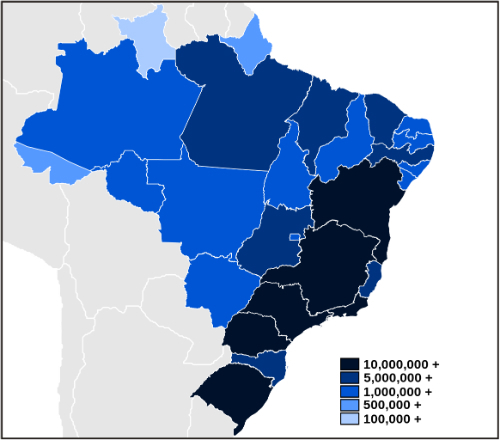Brazil ranks fifth among the most populous countries, surpassed only by China (1.3 billion), India (1.1 billion), the United States (314 million) and Indonesia (229 million).
Despite the entire population, we have around 22.4 inhab./km2, which qualifies the country as sparsely populated.

Demographic Density Map in Brazilian States
Formation of the Brazilian Population
Historically, the population of Brazil was linked to European maritime expansion and the African slave trade that this required.
However, with the prohibition of the slave trade in 1850, a shortage of slaves to work in the fields began. This fact started other types of migration and immigration.
In 1930, an intense process of industrialization and urbanization began in Brazil, of which the Southeast was the most affected region for having been involved early in the industrialization process. For that reason, it became the populous region of the country.
In the 1950s, it was the turn of urban development, when more and more people left the countryside to work in cities, especially in the Southeast.
The main factors were the industrialization and construction of Brasília in the Midwest region from the 1960s onwards.
In cities there were better living conditions, such as health and basic sanitation and, consequently, we have a weakening of the mortality rate.
The new urban qualities and the revolution in the medical field generated a high vegetative growth. That is, the difference between the birth rate and the population's death rate.
It is important to remember that in the 60s, we have the advent of the contraceptive pill, urban life and the entry of women into the labor market. These factors led to a decrease in the birth rate in the country.
We can note that Brazil's demographic dynamics has changed over the last few decades.
We observe the decay of the population growth rate between the decades before the 1970s.
We attribute this decline to an accelerated reduction in the fertility rate, a phenomenon noted in all Brazilian regions, urban and rural.
The direction of the Brazilian population in the first half of this century, both by its caliber and its age structure, is already outlined. Both the change in the mortality rate and in the fertility rate are already very advanced.
THE Brazilian age pyramid, which had a wide base and a narrow top, touting the superiority of children and young people, has recently shown balance characteristics.
That is, while the elderly population (65 and over) will add at high rates, from 2% to 4% per year; the young population will decline.
According to UN projections, from 3.1% in 1970, the elderly Brazilian population will increase to approximately 19% by 2050.
At that time, age subgroups with negative and positive growth will coexist at the heart of young and adult populations.
As shown in aging nations, the Brazilian age trajectory generates challenges. If not resolved, they will lead the country to face difficulties in the coming decades.
The problem of the social security deficit is competing with the important role played by pensions in the income of the elderly, who are often the breadwinners of the family.
However, this is a problem, as the State demonstrates that it is finding it difficult to honor social security commitments.
Learn more about Population growth.
Brazilian population today
Currently, the Brazilian population is 190,732,694 inhabitants (data from IBGE in the 2010 census) and, according to assessments, it should reach 228 million inhabitants by the year 2025.
With a population growth of 1.17% per year, Brazilians have a birth rate (per thousand inhabitants) of 20.40, in contrast to a death rate (per thousand inhabitants) of 6.31. Furthermore, life expectancy in the country is 73 years.
You most populous states they are:
- São Paulo (41.2 million)
- Minas Gerais (19.5 million)
- Rio de Janeiro (15.9 million)
- Bahia (14 million)
- Rio Grande do Sul (10.6 million)
while the less populated states they are:
- Roraima (451.2 thousand)
- Amapá (668.6 thousand)
- Acre (732.7 thousand)
It is worth remembering that the Brazilian population is concentrated in the Southeast, with 80,364,410 inhabitants, while the Northeast has 53,081,950 inhabitants and the South about 27.3 million.
Curiosities
- There is a big difference between the life expectancy of southerners and northeasterners, so that in the south of the country, people live longer than in the northeast.
- The least populated capital of Brazil is Palmas, in the state of Tocantins, with a population of 228.2 thousand inhabitants.
- The most populous city in Brazil is São Paulo, in the State of São Paulo, with a population of 11.2 million inhabitants.
- Harmony between the sexes: 48.92% men and 51.08% women.
- 160.8 million inhabitants live in the Urban Zone, while 29.8 million live in the Rural Zone.
- According to the ethnic groups in Brazil (color or race) we have: Browns: 43.1%; Whites: 47.7%; Blacks: 7.6%; Indigenous: 0.4% and Yellow: 1.1%.
Also read:
- Birth and Mortality Rate
- Vegetative Growth
- Immigration in Brazil


